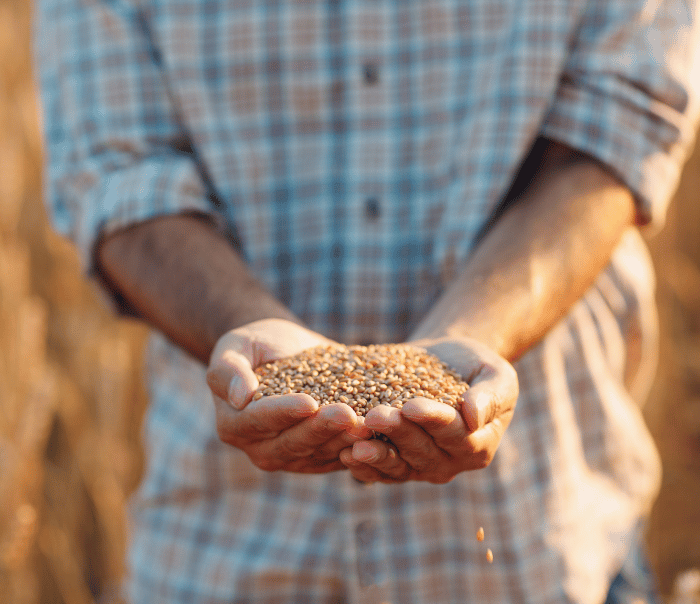How to Choose the Best Seeds for Your Farm: A Comprehensive
Guide
Farming is both an art and a science, and the key to a
successful harvest starts with selecting the right seeds.
Whether you're growing grains, vegetables, or fruits, the
quality, variety, and characteristics of the seeds you
choose determine your farm’s productivity, crop resilience,
and overall success.
A carefully chosen seed can help farmers achieve higher
yields, better disease resistance, and improved adaptability
to local conditions. But with so many options available, how
do you select the best seeds for your farm? This detailed
guide will walk you through every step of the seed selection
process to ensure a successful and profitable farming
season.
Assess Your Farm’s Conditions
Before you purchase seeds, take time to analyze your farm’s
environment. The success of a crop is largely determined by
how well it adapts to the existing conditions. Here’s what
you need to consider:
-
Soil Type –
Conduct a soil test to determine pH levels, fertility,
and nutrient content. Different crops thrive in
different soil conditions.
-
Climate & Weather Patterns –
Choose seeds that match the temperature, humidity, and
seasonal variations of your region. Some crops are more
heat-tolerant, while others thrive in cooler climates.
-
Water Availability –
Understand your irrigation capacity and select seeds
that align with your farm’s water resources.
Drought-resistant varieties can be useful in areas with
limited water access.
Choose High-Quality Seeds
Not all seeds are created equal. The quality of the seed
significantly impacts germination rates, plant health, and
crop yield. Here’s what to look for when selecting
high-quality seeds:
-
Certified Seeds –
Purchase seeds from reputable suppliers like Sri Rama
Seeds to ensure they meet industry standards for purity
and viability.
-
Germination Rate –
High-quality seeds should have an 80-90% germination
rate to ensure maximum plant emergence.
-
Disease-Free & Pest-Resistant –
Check for disease-free certification and ensure the
seeds are resistant to common pests and infections.
-
Storage & Packaging –
Properly stored seeds maintain their viability longer.
Always check packaging dates, storage conditions, and
expiry information.
A simple germination test can help determine seed
viability. Soak a few seeds in water for 24 hours and then
plant them in a moist paper towel. If most of them sprout,
they are viable.
Select the Right Seed Variety
Choosing the right variety of seeds depends on your farming
goals, climate, and crop cycle. There are two main types of
seeds:
Hybrid Seeds
-
Advantages: Higher yield, better disease resistance, and
uniform crop production.
-
Best For: Farmers looking for higher profitability and
consistency.
-
Consideration: Cannot be saved for replanting as they do
not reproduce true to type.
Open-Pollinated Seeds
-
Advantages: More natural, can be saved and replanted for
multiple seasons.
-
Best For: Farmers practicing sustainable or organic
farming.
-
Consideration: May have lower yield than hybrids but are
more adaptable.
Consider Pest & Disease Resistance
Selecting seeds that have built-in resistance to pests and
diseases is a great way to reduce crop losses and minimize
the need for chemical treatments.
-
Research common pests and diseases affecting crops in
your region.
-
Choose varieties that are resistant to these threats.
-
This will reduce pesticide costs and ensure a healthier
crop.
For example, some rice varieties are resistant to bacterial
leaf blight, while certain tomato varieties have natural
resistance to wilt diseases.
Evaluate Yield Potential
The primary goal of every farmer is to achieve a high yield
with minimal input costs. Before selecting a seed variety,
consider:
-
Past Performance Data –
Research how the seed has performed in farms with similar conditions.
-
Productivity Ratings –
Check official seed catalogs and reports for expected yield potential.
-
Farmer Testimonials –
Connect with local farmers who have used the variety and assess their experience.
A high-yield seed should also have good taste, color, and storage quality to attract more buyers in
the market.
Check Maturity Period
Understanding the maturity period of a seed variety helps farmers plan for:
-
Timely Harvesting –
Choose a variety that fits within your seasonal timeline.
-
Crop Rotation –
If you plant multiple crops in a year, selecting a short-duration crop can help optimize land
usage.
-
Market Demand Timing –
If certain crops sell better during specific months, choose seeds with the right growth cycle.
For example, short-duration paddy varieties can be harvested in 90-100 days, while traditional
varieties may take 140+ days.
Consider Market Demand & Profitability
Growing crops that are in high demand ensures better market returns. Before selecting a seed:
-
Research which crops are selling well in your region.
-
Check pricing trends for profitability.
-
Speak to local buyers, wholesalers, and vendors to understand demand.
For example, if organic vegetables are trending, it may be beneficial to grow heirloom or
open-pollinated seed varieties to tap into the premium market.
Source from Trusted Suppliers
To get the best-quality seeds, always purchase from reliable and certified suppliers like Sri Rama
Seeds. A trusted supplier will provide:
-
Genuine, disease-free seeds with high germination rates.
-
Expert advice on selecting the right variety for your farm.
-
Technical support on best farming practices.
Sri Rama Seeds offers a wide range of high-quality seeds, ensuring that farmers get the best start for
their crops.
Conclusion: Invest in the Right Seeds for a Better
Harvest
Selecting the right seeds is one of the most critical decisions for a successful farming season. By
considering soil compatibility, resistance to pests, high yield potential, and market demand, farmers
can maximize productivity and profits.
A successful harvest starts with the right seed—choose wisely.
Let us know how Sri Rama Seeds can help you get the best seeds for your farm.






